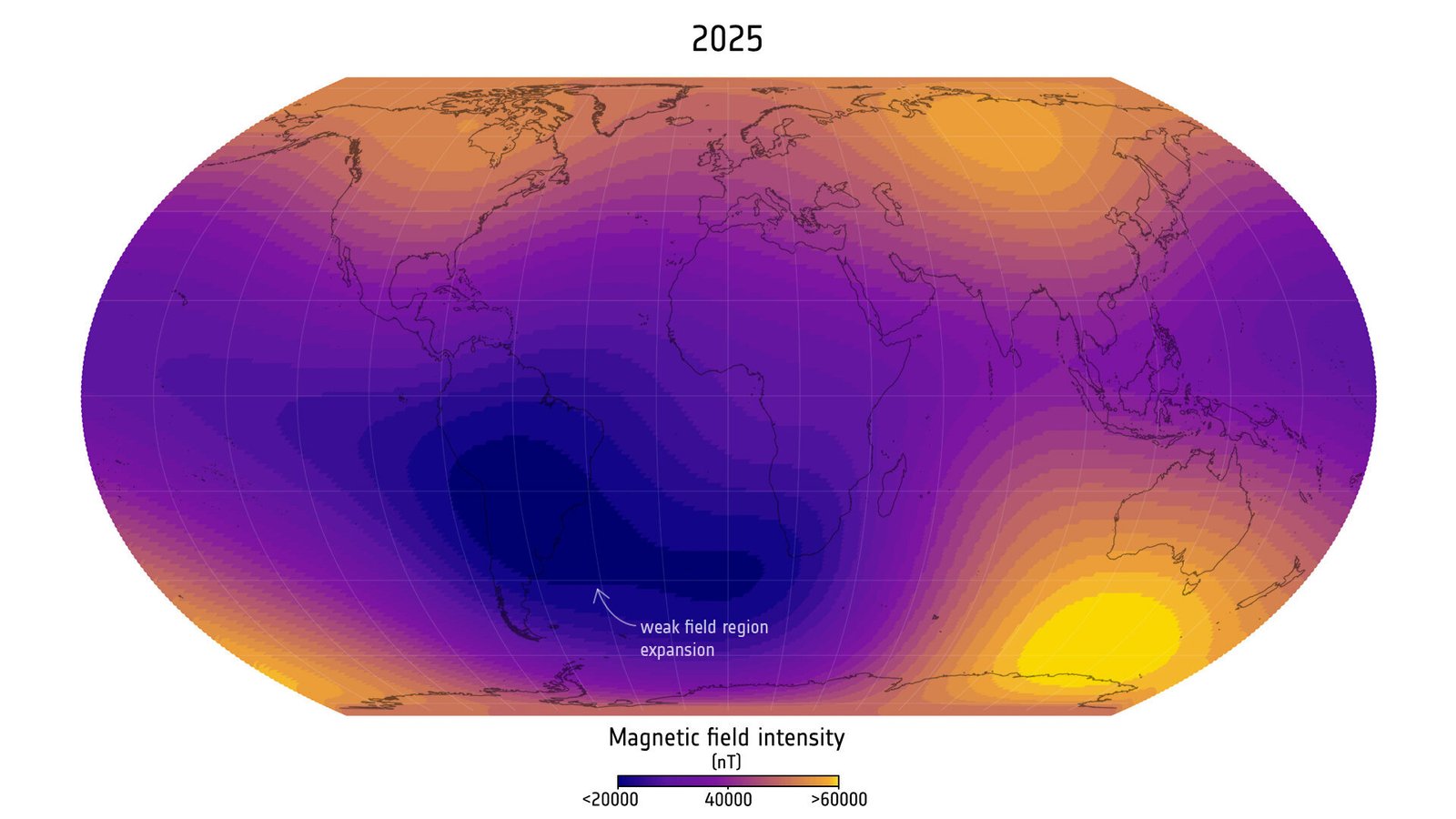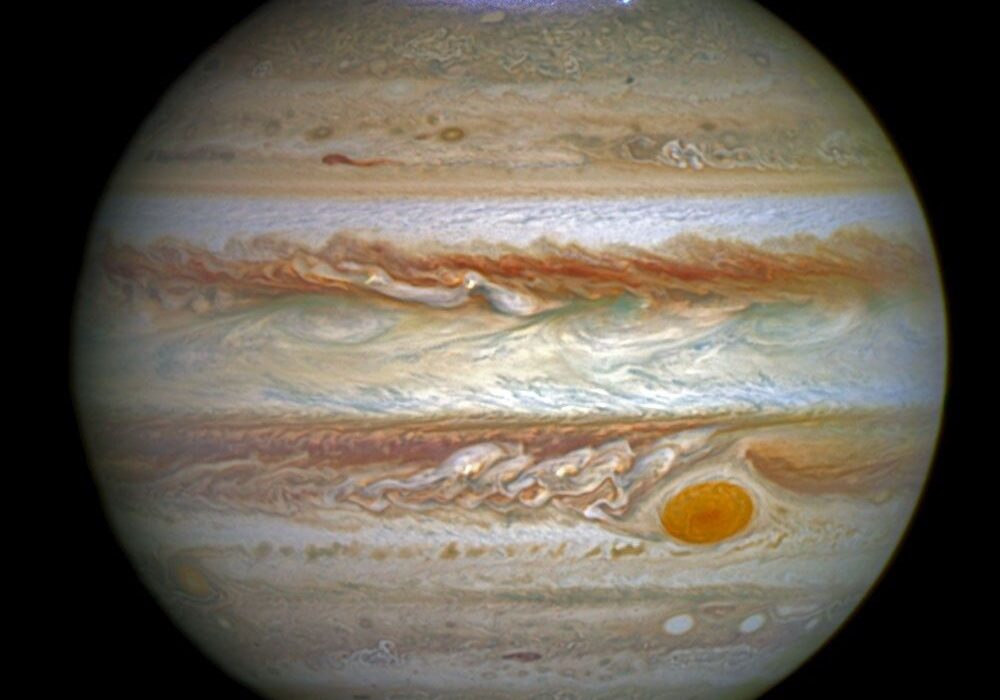Invisible yet immensely powerful, Earth’s magnetic field is our planet’s silent guardian — a shield that protects every living thing from the relentless storm of radiation and charged particles streaming from the Sun. Without it, the atmosphere would erode, satellites would fail, and life as we know it might never have thrived.
But even this ancient force is not constant. It ebbs, flows, twists, and changes. And now, thanks to the European Space Agency’s Swarm mission — a trio of satellites orbiting high above us — scientists have discovered that a vast weak spot in this magnetic armor is growing. Stretching across the South Atlantic, this mysterious region, known as the South Atlantic Anomaly, has expanded by nearly half the size of continental Europe since 2014.
It is a finding both fascinating and sobering — a reminder that our planet is alive, restless, and ever-changing.
The Heart of Earth’s Magnetism
To understand what’s happening, we must first journey deep beneath our feet — about 3,000 kilometers down — to where the outer core of the planet churns in molten fury. This region, composed mainly of liquid iron and nickel, acts like a massive, swirling ocean of metal. As it moves, it generates electrical currents, and those currents, in turn, create magnetic fields.
This self-sustaining process, known as the geodynamo, powers the magnetic field that encircles the planet. It’s the same principle that makes a bicycle dynamo light a lamp as the wheel spins, except on a planetary scale. But unlike a bicycle light, Earth’s dynamo is complex beyond imagination. Its flows and eddies constantly reshape the magnetic field, sometimes strengthening it, sometimes weakening it, and occasionally flipping it entirely — north becoming south and south becoming north, as has happened many times in Earth’s history.
Swarm: Eyes in the Sky
In 2013, the European Space Agency (ESA) launched Swarm, a constellation of three identical satellites designed to map and monitor Earth’s magnetic field with unprecedented precision. Flying in polar orbits, these satellites don’t just track the magnetism produced by the core — they also sense the magnetic signals coming from the crust, the oceans, the ionosphere, and the magnetosphere.
For over a decade, Swarm has given scientists an unparalleled window into Earth’s invisible magnetic landscape. It has become one of the most valuable missions in space science — not only revealing how our planet’s magnetic field is changing, but also offering clues about what’s happening deep inside Earth’s restless heart.
The Expanding Weak Spot
The South Atlantic Anomaly is not a new discovery. It was first identified in the 19th century, southeast of South America. But what Swarm’s 11 years of data now reveal is that this weak spot has been steadily expanding since 2014 — and doing so in ways more complex than scientists expected.
The anomaly is essentially a region where Earth’s magnetic field is unusually weak. Normally, magnetic field lines emerge from the southern hemisphere and loop around to the north, forming the protective bubble known as the magnetosphere. But beneath the South Atlantic, the magnetic field behaves strangely. In some spots, instead of flowing outward, field lines dive back into the core — a reversal of direction that weakens the overall field strength above.
This means that satellites passing through this region — which extends from South America to southwest Africa — are exposed to higher levels of radiation from space. Electronic systems can malfunction, onboard instruments can degrade, and in some cases, satellites have even suffered blackouts. For engineers and mission planners, the South Atlantic Anomaly is a serious challenge.
A Region in Flux
Recent findings published in Physics of the Earth and Planetary Interiors show that while the anomaly continues to expand, it isn’t doing so evenly. “The South Atlantic Anomaly is not just a single block,” explains Professor Chris Finlay, a geomagnetism expert at the Technical University of Denmark and lead author of the new study. “It’s changing differently toward Africa than it is near South America.”
In fact, a region of the Atlantic Ocean southwest of Africa has experienced a particularly rapid weakening of the magnetic field since 2020. Using Swarm data, scientists have identified what they call reverse flux patches — strange zones at the boundary between the liquid outer core and the rocky mantle, where the magnetic field flows in the opposite direction to what is expected.
“Normally, we’d expect magnetic field lines to come out of the core in the southern hemisphere,” says Finlay. “But beneath the South Atlantic Anomaly, we see unexpected areas where the field lines go back into the core. One of these areas is moving westward under Africa, and that’s contributing to the rapid weakening we’re seeing in that region.”
These patterns, though puzzling, are vital clues to understanding the dynamics of Earth’s core — and perhaps, to predicting future changes in the magnetic field.
The Magnetic Field’s Changing Map
Swarm’s decade-long mission has also unveiled other remarkable shifts in the planet’s magnetism. For example, while the field has weakened over the South Atlantic, it has strengthened over Siberia. In the northern hemisphere, there are two main regions of strong magnetic field — one over Canada and the other over Siberia. Over the past decade, the Canadian strong-field area has been shrinking, while the Siberian one has grown.
The Canadian region has contracted by an area equivalent to the size of India, while the Siberian field has expanded by an area the size of Greenland. This shift is linked to the movement of the North Magnetic Pole, which has been steadily drifting from Canada toward Siberia in recent years.
These large-scale shifts highlight that Earth’s magnetic field is not a static dipole like a simple bar magnet, but a dynamic and fluid system driven by complex motions deep within the planet.
The Impact Beyond Earth
Changes in Earth’s magnetic field are more than a scientific curiosity — they have practical and existential implications. Navigation systems, communication networks, and satellites all depend on accurate magnetic models derived from missions like Swarm. Even migratory animals, such as birds, sea turtles, and whales, rely on Earth’s magnetic cues to navigate across vast distances.
A weakening magnetic field could also influence space weather hazards. When solar storms erupt, they send torrents of charged particles toward Earth. Normally, the magnetic field deflects most of this radiation, but in weaker regions like the South Atlantic Anomaly, more of it penetrates deeper into the atmosphere, potentially disrupting electronics and posing risks to astronauts.
A Record of Change and a Glimpse Into the Future
Swarm’s data represent the longest continuous record of magnetic field measurements ever collected from space. It has become the backbone of modern geomagnetic models, crucial for everything from navigation to understanding Earth’s interior.
The mission’s endurance is extraordinary. Launched in November 2013 as part of ESA’s ambitious FutureEO program, the satellites were initially designed as short-term technology demonstrators. Yet, more than a decade later, they remain fully operational, continuing to deliver groundbreaking science.
ESA’s Swarm Mission Manager, Anja Stromme, reflects with pride on this achievement: “It’s really wonderful to see the big picture of our dynamic Earth thanks to Swarm’s extended timeseries. The satellites are all healthy and providing excellent data, so we can hopefully extend that record beyond 2030, when the solar minimum will allow even more unprecedented insights into our planet.”
What Lies Beneath
The deeper mystery lies in the churning heart of our world. The core’s molten motion is like an ocean of metal currents, continuously reshaping the magnetic field. Every eddy and swirl in that fluid iron sea sends ripples through the magnetic field above, sometimes strengthening it, sometimes tearing holes in its armor.
The South Atlantic Anomaly may be one such ripple — a surface sign of powerful, unseen processes below. It could be a precursor to a larger reconfiguration of the magnetic field, or perhaps just one phase in a long, cyclical pattern. Scientists don’t yet know for sure. But with each passing year, the data sharpen our understanding of this vast and restless system.
Living on a Magnetic Planet
The realization that Earth’s magnetic field is changing — that it can weaken, shift, or even flip — can feel unsettling. Yet, this fluidity is what makes our planet so extraordinary. It is a living, breathing world, its magnetic heart pulsing with energy and motion.
For billions of years, the magnetic field has shielded our atmosphere, guided migration, and served as the invisible thread connecting life to the deep interior of our planet. The story of the South Atlantic Anomaly reminds us that even the most stable-seeming forces of nature are in constant flux — and that our understanding of them is still unfolding.
As Swarm continues its silent orbit high above, measuring every twitch of Earth’s magnetic pulse, it gives us more than data. It gives us perspective — a humbling glimpse into the vast, dynamic machinery that keeps our world alive.
And it reminds us that even in the invisible — in the unseen tides of magnetism that ripple through rock, ocean, and sky — lies one of the greatest stories of our planet: the story of a living Earth still writing its own magnetic history.
More information: C.C. Finlay et al, Core field changes from eleven years of Swarm satellite observations, Physics of the Earth and Planetary Interiors (2025). DOI: 10.1016/j.pepi.2025.107447






